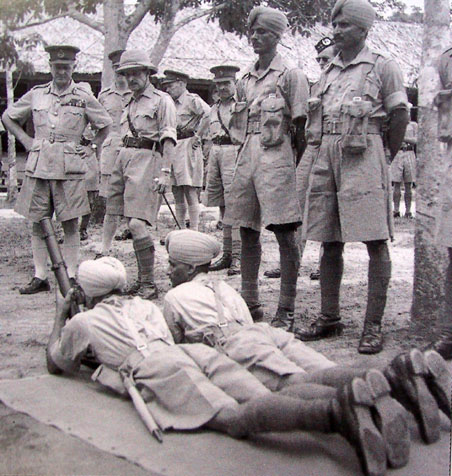
|
"Some of the troops recently arrived from India were raw and their fighting quality was low. Three of the artillery regiments arrived less than a month before the outbreak of hostilities, and had had little opportunity to train with other arms in the peculiarities of jungle warfare."
Lt. Gen. Henry Pownall in his memorandum on Singapore's defences |







The Indian Army on the eve of World War 2 was not a national or
nationalist army. A sizeable minority of the army comprised British
units attached to serve garrison duty in the sub-continent. Most
of the field artillery in india was served by British gunners.
In addition, Gurkha troops from Nepal were another integral component
of the army.
The majority fo the Indian Army's units orignated from within
the borders of today's India and Pakistan. The Indian races noted
for their physique, martial self-image and political reliability,
such as Dogras, Garhwalis, Mahrattas, Sikhs, Jats, Rajputs, Pathans and Punjabi Muslims, were heavily recruited. Soldiers, known as "sepoys" were often enlisted from the same families and villages as existing
servicemen. Like the Australians, the Indian soldiers were volunteers,
but many - mostly teenaged peasants, Sikhs, Gurkhas, Muslims and
Hindus from Punjab and the Frontier province had been in the army
for only a few months. Some were still getting used to wearing
boots... many had never even seen a tank.
The training of forces in Malaya throughout 1941 had been handicapped
by a lack of direction from Malaya Command. While troops in other
theatres of war were accustomed to their equipment and weapons,
formations in Malaya were still in the process of equipment upgrading.
A Punjab regiment officer noted that his unit was forced to train
with wooden anti-tank rifles and had to maintain a supply of primitive
Molotov cocktails. Communications harken back to the last century
as signallers trained with lamps, flags and heliographs instead
of using radio sets. Inexperienced units - officers, NCOs and
enlisted ranks - arriving from India lagged behind in acquiring
new equipment, some of which started arriving only in late 1941.
When the campaign is looked at in review, from the British perspective,
Indian troops have been heavily criticized in light of the mass
desertions to the INA. Yet in the few profitable encounters for
III Indian Corps formations in northern and central Malaya, such
as Kota Bahru and Kampar, Indians were as well-represented as
British and Gurkha troops. Likewise, in Johore the under-prepared
45th indian Brigade fought no better or worse than the novice
53rd British brigade. From 1942 to 1945, Indian Army formations
performed creditably in North Africa, italy and Burma. After a
disastrous opening campaign in Burma, retrained Indian Army won
great victories against Japanese forces in 1944-45.